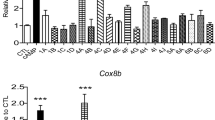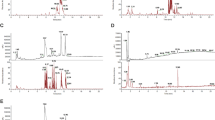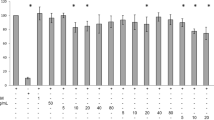Abstract
Objective:
We previously reported that the flavonoid cirsimarin exerts in vitro a strong lipolytic activity on isolated adipocytes. This study was therefore designed to evaluate in vivo the effects of cirsimarin on white adipose tissue (WAT) accretion in mice.
Methods:
Male CD1 mice were injected daily with either vehicle (intraperitoneal (i.p.)) or cirsimarin (25 or 50 mg kg–1 per day, i.p.) for 18 days. Mice were killed and fat pads weighted. Epididymal fat pads were used for cellularity measurement. Effects of cirsimarin treatment on lipolysis and lipogenesis in WAT were assessed.
Results:
Mice treated with 25 or 50 mg kg–1 per day cirsimarin showed a decrease in retroperitoneal (−29 and −37% respectively, P<0.005) and epididymal (−25 and −28% respectively, P<0.005) fat pad weights compared with controls. This effect was restricted to intra-abdominal WAT as no difference was noticed for subcutaneous inguinal WAT. The decrease in intra-abdominal WAT accretion was due to a decrease in adipose cell diameter (−5 and −8% for 25 and 50 mg kg–1 per day cirsimarin, respectively) resulting in a 14 and 35% decrease in adipose cell volume while no change was noticed in total adipocyte number. Direct injection of cirsimarin (50 mg kg–1) to rats did not trigger lipolysis. In contrast, cirsimarin showed in vivo as well as in vitro a strong antilipogenic activity, which may be the critical aspect of its effects on fat accretion in mice. The inhibitory concentration 50% of cirsimarin on lipogenic activity in isolated adipocytes was found to be 1.28±0.04 μM. Cirsimarin given orally reduced intra-abdominal fat accretion in mice.
Conclusion:
Cirsimarin exerts potent antilipogenic effect and decreases adipose tissue deposition in mice. Cirsimarin could therefore be a potential candidate for the treatment of obesity.
This is a preview of subscription content, access via your institution
Access options
Subscribe to this journal
Receive 12 print issues and online access
$259.00 per year
only $21.58 per issue
Buy this article
- Purchase on Springer Link
- Instant access to full article PDF
Prices may be subject to local taxes which are calculated during checkout




Similar content being viewed by others
References
Ross JA, Kasum CM . Dietary flavonoids: bioavailability, metabolic effects, and safety. Annu Rev Nutr 2002; 22: 19–34.
Arts ICW, Hollman PCH . Polyphenols and disease risk in epidemiologic studies. Am J Clin Nutr 2005; 81 (1 Suppl): 317S–325S.
Choi E, Hwang J . Effect of some medicinal plants on plasma antioxidant system and lipid levels in rats. Phytother Res 2005; 19: 382–386.
Kris-Etherton PM, Lefevre M, Beecher GR, Gross MD, Keen CL, Etherton TD . Bioactive compounds in nutrition and health-research methodologies for establishing biological function: the antioxidant and anti-inflammatory effects of flavonoids on atherosclerosis. Annu Rev Nutr 2004; 24: 511–538.
Nagao T, Komine Y, Soga S, Meguro S, Hase T, Tanaka Y et al. Ingestion of a tea rich in catechins leads to a reduction in body fat and malondialdehyde-modified LDL in men. Am J Clin Nutr 2005; 81: 122–129.
Nagao T, Hase T, Tokimitsu I . A green tea extract high in catechins reduces body fat and cardiovascular risks in humans. Obesity (Silver Spring) 2007; 15: 1473–1483.
Wolfram S, Wang Y, Thielecke F . Anti-obesity effects of green tea: from bedside to bench. Mol Nutr Food Res 2006; 50: 176–187.
Kuppusamy UR, Das NP . Effects of flavonoids on cyclic AMP phosphodiesterase and lipid mobilization in rat adipocytes. Biochem Pharmacol 1992; 44: 1307–1315.
Liang H, Belardinelli L, Ozeck MJ, Shryock JC . Tonic activity of the rat adipocyte A1-adenosine receptor. Br J Pharmacol 2002; 135: 1457–1466.
Honnor RC, Dhillon GS, Londos C . cAMP-dependent protein kinase and lipolysis in rat adipocytes. I. Cell preparation, manipulation, and predictability in behavior. J Biol Chem 1985; 260: 15122–15129.
Honnor RC, Dhillon GS, Londos C . cAMP-dependent protein kinase and lipolysis in rat adipocytes. II. Definition of steady-state relationship with lipolytic and antilipolytic modulators. J Biol Chem 1985; 260: 15130–15138.
Hasrat JA, De Bruyne T, De Backer JP, Vauquelin G, Vlietinck AJ . Cirsimarin and cirsimaritin, flavonoids of Microtea debilis (Phytolaccaceae) with adenosine antagonistic properties in rats: leads for new therapeutics in acute renal failure. J Pharm Pharmacol 1997; 49: 1150–1156.
Hasrat JA, Pieters L, Claeys M, Vlietinck A, De Backer JP, Vauquelin G . Adenosine-1 active ligands: cirsimarin, a flavone glycoside from Microtea debilis. J Nat Prod 1997; 60: 638–641.
Girotti C, Ginet M, Demarne FC, Lagarde M, Géloën A . Lipolytic activity of cirsimarin extracted from Microtea debilis. Planta Med 2005; 71: 1170–1172.
Kavvadias D, Sand P, Youdim KA, Qaiser MZ, Rice-Evans C, Baur R et al. The flavone hispidulin, a benzodiazepine receptor ligand with positive allosteric properties, traverses the blood-brain barrier and exhibits anticonvulsive effects. Br J Pharmacol 2004; 142: 811–820.
Folch J, Lees M, Sloane Stanley GH . A simple method for the isolation and purification of total lipides from animal tissues. J Biol Chem 1957; 226: 497–509.
Rodbell M . Metabolism of isolated fat cells. I. effects of hormones on glucose metabolism and lipolysis. J Biol Chem 1964; 239: 375–380.
Briquet-Laugier V, Dugail I, Ardouin B, Le Liepvre X, Lavau M, Quignard-Boulangé A . Evidence for a sustained genetic effect on fat storage capacity in cultured adipose cells from Zucker rats. Am J Physiol 1994; 267 (3 Part 1): E439–E446.
Smith U, Sjöström L, Björnstorp P . Comparison of two methods for determining human adipose cell size. J Lipid Res 1972; 13: 822–824.
Björnheden T, Jakubowicz B, Levin M, Odén B, Edén S, Sjöström L et al. Computerized determination of adipocyte size. Obes Res 2004; 12: 95–105.
Lowry OH, Rosebrough NJ, Farr AL, Randall RJ . Protein measurement with the Folin phenol reagent. J Biol Chem 1951; 193: 265–275.
Labarca C, Paigen K . A simple, rapid, and sensitive DNA assay procedure. Anal Biochem 1980; 102: 344–352.
Cohen J, Mares V, Lodin Z . DNA content of purified preparations of mouse Purkinje neurons isolated by a velocity sedimentation technique. J Neurochem 1973; 20: 651–657.
Ibrahim MM . Subcutaneous and visceral adipose tissue: structural and functional differences. Obes Rev (Internet) 28 July 2009; available from: 2009 http://www.ncbi.nlm.nih.gov/pubmed/19656312.
Szkudelska K, Nogowski L, Szkudelski T . Genistein affects lipogenesis and lipolysis in isolated rat adipocytes. J Steroid Biochem Mol Biol 2000; 75: 265–271.
Naaz A, Yellayi S, Zakroczymski MA, Bunick D, Doerge DR, Lubahn DB et al. The soy isoflavone genistein decreases adipose deposition in mice. Endocrinology 2003; 144: 3315–3320.
Formica JV, Regelson W . Review of the biology of Quercetin and related bioflavonoids. Food Chem Toxicol 1995; 33: 1061–1080.
Fuhr U, Kummert AL . The fate of naringin in humans: a key to grapefruit juice-drug interactions? Clin Pharmacol Ther 1995; 58: 365–373.
Smith S . The animal fatty acid synthase: one gene, one polypeptide, seven enzymes. FASEB J 1994; 8: 1248–1259.
Wakil SJ . Fatty acid synthase, a proficient multifunctional enzyme. Biochemistry 1989; 28: 4523–4530.
Chirala SS, Wakil SJ . Structure and function of animal fatty acid synthase. Lipids 2004; 39: 1045–1053.
Loftus TM, Jaworsky DE, Frehywot GL, Townsend CA, Ronnett GV, Lane MD et al. Reduced food intake and body weight in mice treated with fatty acid synthase inhibitors. Science 2000; 288: 2379–2381.
Li BH, Tian WX . Inhibitory effects of flavonoids on animal fatty acid synthase. J Biochem 2004; 135: 85–91.
Thupari JN, Kim E, Moran TH, Ronnett GV, Kuhajda FP . Chronic C75 treatment of diet-induced obese mice increases fat oxidation and reduces food intake to reduce adipose mass. Am J Physiol Endocrinol Metab 2004; 287: E97–E104.
Tu Y, Thupari JN, Kim E, Pinn ML, Moran TH, Ronnett GV et al. C75 alters central and peripheral gene expression to reduce food intake and increase energy expenditure. Endocrinology 2005; 146: 486–493.
Cha SH, Hu Z, Lane MD . Long-term effects of a fatty acid synthase inhibitor on obese mice: food intake, hypothalamic neuropeptides, and UCP3. Biochem Biophys Res Commun 2004; 317: 301–308.
Dridi S, Ververken C, Hillgartner FB, Arckens L, Lutgarde A, Van der Gucht E et al. FAS inhibitor cerulenin reduces food intake and melanocortin receptor gene expression without modulating the other (an)orexigenic neuropeptides in chickens. Am J Physiol Regul Integr Comp Physiol 2006; 291: R138–R147.
Obici S, Feng Z, Morgan K, Stein D, Karkanias G, Rossetti L . Central administration of oleic acid inhibits glucose production and food intake. Diabetes 2002; 51: 271–275.
Kim E, Miller I, Aja S, Landree LE, Pinn M, McFadden J et al. C75, a fatty acid synthase inhibitor, reduces food intake via hypothalamic AMP-activated protein kinase. J Biol Chem 2004; 279: 19970–19976.
Landree LE, Hanlon AL, Strong DW, Rumbaugh G, Miller IM, Thupari JN et al. C75, a fatty acid synthase inhibitor, modulates AMP-activated protein kinase to alter neuronal energy metabolism. J Biol Chem 2004; 279: 3817–3827.
Pedersen SB, Børglum JD, Møller-Pedersen T, Richelsen B . Effects of in vivo estrogen treatment on adipose tissue metabolism and nuclear estrogen receptor binding in isolated rat adipocytes. Mol Cell Endocrinol 1992; 85: 13–19.
Cooke PS, Heine PA, Taylor JA, Lubahn DB . The role of estrogen and estrogen receptor-alpha in male adipose tissue. Mol Cell Endocrinol 2001; 178: 147–154.
Bhathena SJ, Velasquez MT . Beneficial role of dietary phytoestrogens in obesity and diabetes. Am J Clin Nutr 2002; 76: 1191–1201.
Kuiper GG, Lemmen JG, Carlsson B, Corton JC, Safe SH, van der Saag PT et al. Interaction of estrogenic chemicals and phytoestrogens with estrogen receptor beta. Endocrinology 1998; 139: 4252–4263.
Farmakalidis E, Hathcock JN, Murphy PA . Oestrogenic potency of genistin and daidzin in mice. Food Chem Toxicol 1985; 23: 741–745.
Acknowledgements
We gratefully acknowledge FE Demarne (Gattefossé SA, Saint Priest, France) for the kind gift of Cirsimarin. Bader Zarrouki and Nicolas Pillon are recipient for grants from the French ‘Ministère de l’Education Nationale, de la Recherche et de la Technologie’. This project was supported by a grant from INSA-Lyon (grant ‘BQR 2009’) to C Soulage and S Chambert.
Author information
Authors and Affiliations
Corresponding author
Ethics declarations
Competing interests
The authors declare no conflict of interest.
Additional information
Supplementary Information accompanies the paper on International Journal of Obesity website ()
Rights and permissions
About this article
Cite this article
Zarrouki, B., Pillon, N., Kalbacher, E. et al. Cirsimarin, a potent antilipogenic flavonoid, decreases fat deposition in mice intra-abdominal adipose tissue. Int J Obes 34, 1566–1575 (2010). https://doi.org/10.1038/ijo.2010.85
Received:
Revised:
Accepted:
Published:
Issue Date:
DOI: https://doi.org/10.1038/ijo.2010.85
Keywords
This article is cited by
-
HPLC–UV analysis of sample preparation influence on flavonoid yield from Cirsium japonicum var. maackii
Applied Biological Chemistry (2017)



